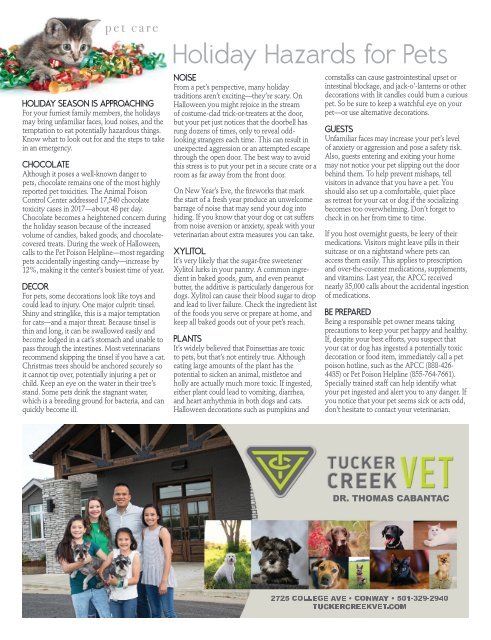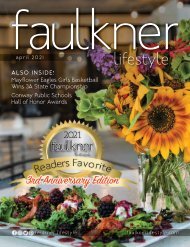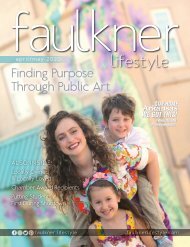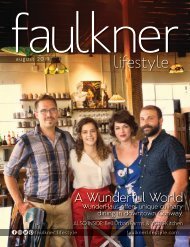Fall 2020 Faulkner Lifestyle
We hope you enjoy our largest issue to date! www.faulknerlifestyle.com
We hope you enjoy our largest issue to date!
www.faulknerlifestyle.com
- No tags were found...
Create successful ePaper yourself
Turn your PDF publications into a flip-book with our unique Google optimized e-Paper software.
pet care<br />
HOLIDAY SEASON IS APPROACHING<br />
For your furriest family members, the holidays<br />
may bring unfamiliar faces, loud noises, and the<br />
temptation to eat potentially hazardous things.<br />
Know what to look out for and the steps to take<br />
in an emergency.<br />
CHOCOLATE<br />
Although it poses a well-known danger to<br />
pets, chocolate remains one of the most highly<br />
reported pet toxicities. The Animal Poison<br />
Control Center addressed 17,540 chocolate<br />
toxicity cases in 2017—about 48 per day.<br />
Chocolate becomes a heightened concern during<br />
the holiday season because of the increased<br />
volume of candies, baked goods, and chocolatecovered<br />
treats. During the week of Halloween,<br />
calls to the Pet Poison Helpline—most regarding<br />
pets accidentally ingesting candy—increase by<br />
12%, making it the center’s busiest time of year.<br />
DECOR<br />
For pets, some decorations look like toys and<br />
could lead to injury. One major culprit: tinsel.<br />
Shiny and stringlike, this is a major temptation<br />
for cats—and a major threat. Because tinsel is<br />
thin and long, it can be swallowed easily and<br />
become lodged in a cat’s stomach and unable to<br />
pass through the intestines. Most veterinarians<br />
recommend skipping the tinsel if you have a cat.<br />
Christmas trees should be anchored securely so<br />
it cannot tip over, potentially injuring a pet or<br />
child. Keep an eye on the water in their tree’s<br />
stand. Some pets drink the stagnant water,<br />
which is a breeding ground for bacteria, and can<br />
quickly become ill.<br />
Holiday Hazards for Pets<br />
NOISE<br />
From a pet’s perspective, many holiday<br />
traditions aren’t exciting—they’re scary. On<br />
Halloween you might rejoice in the stream<br />
of costume-clad trick-or-treaters at the door,<br />
but your pet just notices that the doorbell has<br />
rung dozens of times, only to reveal oddlooking<br />
strangers each time. This can result in<br />
unexpected aggression or an attempted escape<br />
through the open door. The best way to avoid<br />
this stress is to put your pet in a secure crate or a<br />
room as far away from the front door.<br />
On New Year’s Eve, the fireworks that mark<br />
the start of a fresh year produce an unwelcome<br />
barrage of noise that may send your dog into<br />
hiding. If you know that your dog or cat suffers<br />
from noise aversion or anxiety, speak with your<br />
veterinarian about extra measures you can take.<br />
XYLITOL<br />
It’s very likely that the sugar-free sweetener<br />
Xylitol lurks in your pantry. A common ingredient<br />
in baked goods, gum, and even peanut<br />
butter, the additive is particularly dangerous for<br />
dogs. Xylitol can cause their blood sugar to drop<br />
and lead to liver failure. Check the ingredient list<br />
of the foods you serve or prepare at home, and<br />
keep all baked goods out of your pet’s reach.<br />
PLANTS<br />
It’s widely believed that Poinsettias are toxic<br />
to pets, but that’s not entirely true. Although<br />
eating large amounts of the plant has the<br />
potential to sicken an animal, mistletoe and<br />
holly are actually much more toxic. If ingested,<br />
either plant could lead to vomiting, diarrhea,<br />
and heart arrhythmia in both dogs and cats.<br />
Halloween decorations such as pumpkins and<br />
cornstalks can cause gastrointestinal upset or<br />
intestinal blockage, and jack-o’-lanterns or other<br />
decorations with lit candles could burn a curious<br />
pet. So be sure to keep a watchful eye on your<br />
pet—or use alternative decorations.<br />
GUESTS<br />
Unfamiliar faces may increase your pet’s level<br />
of anxiety or aggression and pose a safety risk.<br />
Also, guests entering and exiting your home<br />
may not notice your pet slipping out the door<br />
behind them. To help prevent mishaps, tell<br />
visitors in advance that you have a pet. You<br />
should also set up a comfortable, quiet place<br />
as retreat for your cat or dog if the socializing<br />
becomes too overwhelming. Don’t forget to<br />
check in on her from time to time.<br />
If you host overnight guests, be leery of their<br />
medications. Visitors might leave pills in their<br />
suitcase or on a nightstand where pets can<br />
access them easily. This applies to prescription<br />
and over-the-counter medications, supplements,<br />
and vitamins. Last year, the APCC received<br />
nearly 35,000 calls about the accidental ingestion<br />
of medications.<br />
BE PREPARED<br />
Being a responsible pet owner means taking<br />
precautions to keep your pet happy and healthy.<br />
If, despite your best efforts, you suspect that<br />
your cat or dog has ingested a potentially toxic<br />
decoration or food item, immediately call a pet<br />
poison hotline, such as the APCC (888-426-<br />
4435) or Pet Poison Helpline (855-764-7661).<br />
Specially trained staff can help identify what<br />
your pet ingested and alert you to any danger. If<br />
you notice that your pet seems sick or acts odd,<br />
don’t hesitate to contact your veterinarian.<br />
DR. THOMAS CABANTAC<br />
2725 COLLEGE AVE • CONWAY • 501-329-2940<br />
TUCKERCREEKVET.COM<br />
faulknerlifestyle.com 91
















